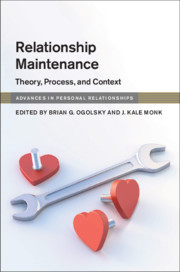Book contents
- Relationship Maintenance
- Advances in Personal Relationships
- Relationship Maintenance
- Copyright page
- Contents
- Tables
- Figures
- Contributors
- Part I Introduction
- Part II Theories of Relationship Maintenance
- 2 Interdependence Perspectives on Relationship Maintenance
- 3 An Evolutionary, Life History Theory Perspective on Relationship Maintenance
- 4 Relationship Maintenance from an Attachment Perspective
- 5 Uncertainty Perspectives on Relationship Maintenance
- 6 The Self-Expansion Model and Relationship Maintenance
- Part III Processes of Relationship Maintenance
- Part IV The Social Context of Relationship Maintenance
- Part V Conclusion
- Index
- References
4 - Relationship Maintenance from an Attachment Perspective
from Part II - Theories of Relationship Maintenance
Published online by Cambridge University Press: 02 December 2019
- Relationship Maintenance
- Advances in Personal Relationships
- Relationship Maintenance
- Copyright page
- Contents
- Tables
- Figures
- Contributors
- Part I Introduction
- Part II Theories of Relationship Maintenance
- 2 Interdependence Perspectives on Relationship Maintenance
- 3 An Evolutionary, Life History Theory Perspective on Relationship Maintenance
- 4 Relationship Maintenance from an Attachment Perspective
- 5 Uncertainty Perspectives on Relationship Maintenance
- 6 The Self-Expansion Model and Relationship Maintenance
- Part III Processes of Relationship Maintenance
- Part IV The Social Context of Relationship Maintenance
- Part V Conclusion
- Index
- References
Summary
Here, we adopt an attachment theoretical perspective on relationship maintenance, based on the idea that a romantic relationship is an attachment bond. In doing so, we emphasize the role of normative attachment processes. We commence by introducing the attachment behavioral system and its three functions of proximity seeking/maintenance, safe haven, and secure base. We then describe the associations between normative attachment processes and relationship maintenance, including a discussion of evolutionary functions. The following part of the chapter explains how individual differences in attachment organization emerge based on early experiences with attachment figures, and why these differences are associated with relationship maintenance. Next, we review the literature on the associations of attachment style with three maintenance behaviors that have been widely studied in relation to attachment: support, communication, and commitment-enhancing behaviors. We conclude our chapter by discussing the association between attachment style and relationship satisfaction, which is regarded as an indicator of successful relationship maintenance. Overall, the normative processes of the attachment system align well with relationship maintenance behaviors, and attachment security tends to positively predict the enactment of maintenance behaviors.
Keywords
- Type
- Chapter
- Information
- Relationship MaintenanceTheory, Process, and Context, pp. 47 - 68Publisher: Cambridge University PressPrint publication year: 2019

